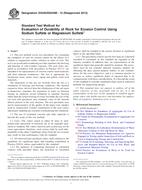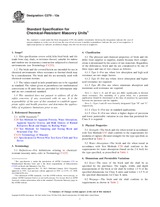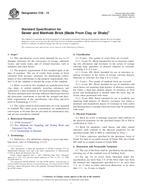Wir benötigen Ihre Einwilligung zur Verwendung der einzelnen Daten, damit Sie unter anderem Informationen zu Ihren Interessen einsehen können. Klicken Sie auf "OK", um Ihre Zustimmung zu erteilen.
ASTM D5240/D5240M-12(2013)
Standard Test Method for Evaluation of Durability of Rock for Erosion Control Using Sodium Sulfate or Magnesium Sulfate
Automatische name übersetzung:
Standard Test Method for Evaluation der Haltbarkeit of Rock für Erosionsschutz mit Natriumsulfat oder Magnesiumsulfat
NORM herausgegeben am 15.1.2013
Informationen über die Norm:
Bezeichnung normen: ASTM D5240/D5240M-12(2013)
Anmerkung: UNGÜLTIG
Ausgabedatum normen: 15.1.2013
SKU: NS-30416
Zahl der Seiten: 7
Gewicht ca.: 21 g (0.05 Pfund)
Land: Amerikanische technische Norm
Kategorie: Technische Normen ASTM
Kategorie - ähnliche Normen:
Die Annotation des Normtextes ASTM D5240/D5240M-12(2013) :
Keywords:
riprap, rock defects, rock durability, rock weathering, soundness of riprap, ICS Number Code 91.100.15 (Mineral materials and products)
Ergänzende Informationen
| Significance and Use | ||||||||||||||||||||||
|
5.1 Rock for erosion control consists of individual pieces of natural stone. The ability of these individual pieces of stone to resist deterioration due to weathering action affects the stability of the integral placement of rock for erosion control and hence, the stability of construction projects, structures, shorelines, and stream banks. 5.2 The sodium sulfate or magnesium sulfate soundness test is one method by which to estimate qualitatively the durability of rock under weathering conditions. This test method was developed to be used in conjunction with additional test methods listed in Practice D4992. This test method does not provide an absolute value, but rather an indication of the resistance to freezing and thawing; therefore, the results of this test method are not to be used as the sole basis for the determination of rock durability. 5.3 This test method has been used to evaluate many different types of rocks. There have been occasions when test results have provided data that have not agreed with the durability of rock under actual field conditions; samples yielding a low soundness loss have disintegrated in actual usage, and the reverse has been true. 1.1 This test method covers test
procedures for evaluating the soundness of rock for erosion control
by the effects of a sodium or magnesium sulfate solution on slabs
of rock. The test is an accelerated weathering test that simulates
the freezing and thawing of cold weather exposure. The rock slabs,
prepared in accordance with procedures in Practice D5121, are
intended to be representative of erosion control sized materials
and their inherent weaknesses. The test is appropriate for
breakwater stone, armor stone, riprap and gabion sized rock
materials.
The limitations of this test are twofold. First the test is a simulation of freezing and thawing conditions. The internal expansive force, derived from the rehydration of the salt upon re-immersion, simulates the expansion of water on freezing relying on chemical crystal formation to simulate freezing rather than the actual freezing of water. Secondly the size of the cut rock slab specimens may eliminate some of the internal defects present in the rock structure. The test specimens may not be representative of the quality of the larger rock samples used in construction. Careful examination of the rock source and proper sampling are essential in minimizing this limitation. 1.2 The use of reclaimed concrete and other materials is beyond the scope of this test method. 1.3 Units—The values stated in either SI units or inch-pound units [presented in brackets] are to be regarded separately as standard. The values stated in each system may not be exact equivalents; therefore, each system shall be used independently of the other. Combining values from the two systems may result in non-conformance with the standard. 1.4 All observed and calculated values shall conform to the guidelines for significant digits and rounding established in Practice D6026, unless superseded by this standard. 1.4.1 For purposes of comparing measured or calculated value(s) with specified limits, the measured or calculated value(s) shall be rounded to the nearest decimal or significant digits in the specified limits. 1.4.2 The procedures used to specify how data are collected/recorded or calculated, in this standard are regarded as the industry standard. In addition, they are representative of the significant digits that generally should be retained. The procedures used do not consider material variation, purpose for obtaining the data, special purpose studies, or any considerations for the user’s objectives; and it is common practice to increase or reduce significant digits of reported data to be commensurate with these considerations. It is beyond the scope of this standard to consider significant digits used in analytical methods for engineering design. 1.5 This standard does not purport to address all of the safety concerns, if any, associated with its use. It is the responsibility of the user of this standard to establish appropriate safety and health practices and determine the applicability of regulatory limitations prior to use. |
||||||||||||||||||||||
| 2. Referenced Documents | ||||||||||||||||||||||
|
Ähnliche Normen:
Historisch
1.5.2014
Historisch
1.2.2014
Historisch
1.4.2009
Historisch
1.5.2013
Historisch
15.12.2013
Historisch
1.6.2013
Empfehlungen:
Aktualisierung der technischen Normen
Wollen Sie sich sicher sein, dass Sie nur die gültigen technischen Normen verwenden?
Wir bieten Ihnen eine Lösung, die Ihnen eine Monatsübersicht über die Aktualität der von Ihnen angewandten Normen sicher stellt.
Brauchen Sie mehr Informationen? Sehen Sie sich diese Seite an.



 ASTM C1799/C1799M-14..
ASTM C1799/C1799M-14.. ASTM C216-14
ASTM C216-14 ASTM C217/C217M-09..
ASTM C217/C217M-09.. ASTM C241/C241M-13..
ASTM C241/C241M-13.. ASTM C279-13a
ASTM C279-13a ASTM C32-13
ASTM C32-13
 Cookies
Cookies
